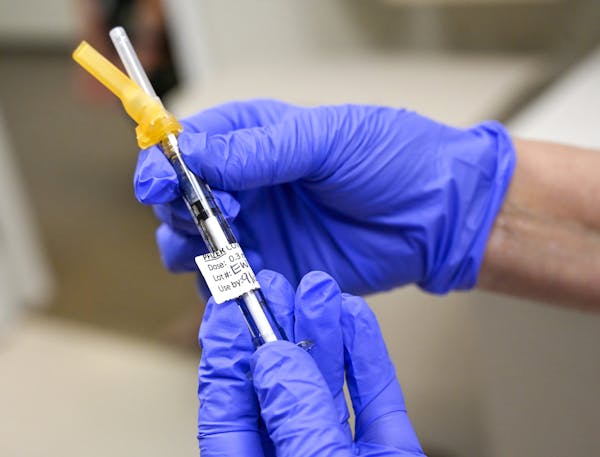Minnesota is preparing to expand COVID-19 vaccine booster access to all adults this week, with or without federal backing, and encouraged renewed protections in communities and schools against a worsening pandemic wave.
The positivity rate of COVID-19 diagnostic testing rose above a 10% high-risk threshold in Minnesota, which is reporting high viral transmission levels in 86 of 87 counties but particularly severe levels in central and northern counties with lower vaccination rates.
"I don't think we can say that any place in Minnesota is in particularly great shape right now," state Health Commissioner Jan Malcolm said.
Wadena County had the highest rate of infections over the past seven days and a first-dose vaccination rate of 58% among people 12 and older that is below the state rate of 78%, according to the Centers for Disease Control and Prevention. Kanabec County had the state's seventh-worst new infection rate and its lowest first-dose vaccination rate of 47% for people 12 and older.
Unvaccinated people should seek shots and vaccinated people should seek boosters when recommended, but Malcolm said additional measures such as mask-wearing and social distancing may be needed with the holidays approaching to slow viral spread.
A state nine-point plan encouraged K-12 schools to require mask-wearing per federal guidance and to use strategies such as surveillance testing, improved ventilation and social distancing to protect staff and students. Schools have been eyed as hot spots for transmission of the fast-spreading delta variant of the coronavirus because children 5 to 11 weren't eligible for vaccine until early November.
Regional spread of the virus doesn't entirely conform to vaccination rates. Breakthrough COVID-19 cases have increased among the state's earliest vaccine recipients who are encountering waning immunity.
Southwestern Jackson County is below the state vaccination average but had the lowest rate of infections over the past week. Goodhue County is experiencing a COVID-19 surge despite an average vaccination rate. Two of the southeastern county's residents in the 15 to 19 and 35 to 39 age ranges were among the 51 COVID-19 deaths reported by Minnesota on Tuesday.
Boosters are recommended for all recipients of the Johnson & Johnson vaccine and recipients of the other vaccines who are seniors or younger adults with health problems or jobs that present infection risks. The federal government could expand eligibility to all adults this week, but Malcolm said Minnesota might need to act faster than that given it has the nation's highest rate of new infections.
"Given the very serious circumstances here in Minnesota, we have been communicating with our federal partners that we are preparing to move ahead independently this week to expand booster eligibility if there is no action at the federal level," she said.
Minnesota's totals in the pandemic increased to 857,791 infections and 9,047 COVID-19 deaths. They include 10,913 infections that were reported Tuesday by the Minnesota Department of Health and reflect cases identified over the weekend.
COVID-19 hospitalizations rose to 1,348 on Monday and included 307 people requiring intensive care. A public health alert last week in northern Itasca County — which has the 10th highest rate of new infections — indicated that all critical care hospital beds in the region were full.
"We are at the crisis levels of 2020, but without the same levels of COVID precautions in place," said Kelly Chandler of Itasca County Public Health. "For your own sakes, dig out your masks and limit your exposure to groups, especially indoors. Go back to social distancing. And definitely get your COVID vaccine and flu shot if you haven't already — you are far less likely to need an ICU bed if you do."
The latest wave is unique because it is being fueled by a fast-spreading delta variant. It is numerically similar to last fall's wave, though.
The rolling seven-day average of test positivity reached 10.3% on Nov. 8, according to the latest state data. In 2020, the state rose above 10% on Oct. 29.
A pattern of COVID-19 activity might be emerging in the U.S. after nearly two years, but it can't be explained by seasonality given infection growth in the northern U.S. but also in Phoenix and Albuquerque where temperatures are in the 70s, said Michael Osterholm, director of the University of Minnesota's Center for Infectious Disease Research and Policy. "This makes Rubik's Cube seem pretty easy."
Gov. Tim Walz suspended indoor gatherings and bar and restaurant service for four weeks starting Nov. 21, 2020, in response to last fall's wave but no longer has the emergency peacetime authority to issue such restrictions.
Malcolm said she doesn't expect another emergency declaration, but that broad access to vaccine and testing differentiates the current situation from the "big surges of last fall."
"We now really do have the tools that we need to be able to respond to this surge … as individual citizens and as communities," she said.
Immunity appears to wane six or more months after vaccination, but studies show the shots remain strongly protective against severe illness, hospitalization and death.
Observational data from Minnesota hospitals show that unvaccinated people make up most of their COVID-19 admissions and require more invasive medical care.
Among 490 COVID-19 patients admitted to HealthPartners hospitals in Minnesota and Wisconsin over the last 30 days, 68% weren't fully vaccinated.
Among 52 patients on ventilators, 75% weren't fully vaccinated.
Staff writer Christopher Snowbeck contributed to this report.
Two stalled Duluth housing projects move ahead

Omar appears at pro-Palestinian protest at University of Minnesota; 9 arrested earlier
2 dead in Lino Lakes, no known threat to public, police say
Teen charged with murder in deadly St. Paul shooting last month

